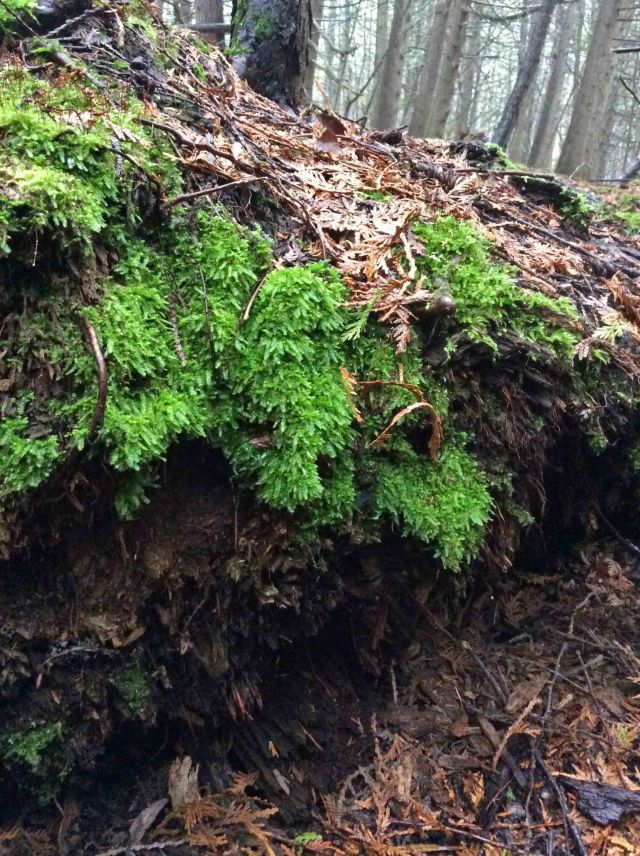
Wet cedar forest, Trent Nature Sanctuary (photo by Nina Munteanu)
I entered the large cedar swamp-forest, feeling magic touch my shoulder.
It wasn’t just the deep soggy forest and the twittering birds or the fresh pungent smell of cedar in the air. Or the lanky trees creaking in the warm wind. There was something in the air that stirred my senses. The magic of discovery.
Amid the soft hush of the breeze through the leaves, the tall trees leaned into each other, groaning and clanking like whispering gossips. Moss crept up their widely planted feet. It carpeted the russet duff on the ground with splashes of fluorescent green.
Several over two-hundred-year old cedars had fallen and their decaying bodies were feeding a whole new generation of trees. I left the path and climbed onto a several metre-wide and twenty-metre long moss-covered cedar corpse. My steps sprang over spongy ground—now a mixture of rich soil, decaying wood, fungus and detritus. I could make out the black fibrous layers of decaying wood beneath a carpet of moss and dead leaves.

Large moss-covered cedar log (photo by Nina Munteanu)
I’ve been told that the heartwood of eastern white cedar (Thuja occidentalis) is highly resistant to moisture, decay and insect infestation due to the phytoncides (oils and acids) it produces; it’s these compounds that give off its distinctive pleasant and calming aroma. Many of the compounds are variants of thujone and include alpha pinene, alpha thujone, beta thujone, bornyl acetate, camphene, camphone, delta sabinene, fenchone and terpinenol.
A fallen cedar can remain intact on the forest floor for over a century, slowly decomposing. “This durability is the result of a natural preservative that is toxic to decay-causing fungi,” says forester Jeri Chase, who adds that this ability does not decrease with age; in fact, it increases.

Cedar growing on old cedar log (photo by Nina Munteanu)
Nursery logs provide rich habitat for seedlings to take root and a complexity of growing plants, fungi, liverworts, and other wildlife to thrive. These ancient trees play a vital role in climate balance. They store two to three times more carbon than second-growth trees. Because of their slow decay, cedars lock more carbon in their biomass for a longer period—creating a slow and efficient carbon store. Even dead snags and nursery logs continue to store carbon as they provide habitat for other living things.
The Magic of Puffballs
Fascinated by the bright moss that was fruiting in profusion, I crawled on all fours with my camera to get some close shots and stumbled into the dip between two giant decayed logs.

Puffballs litter the ground between two old cedar logs (photo by Nina Munteanu)
There, like Indiana Jones in the deep jungles of Borneo, I discovered my hidden gold: puffballs!
A million of them it seemed. Whitish, round and with a paper-like texture, each plump spore sac pouted with a beaked mouth (peristome) and was surrounded by a star-like “collar” or exoperidium with decorative cracks and fissures. I identified the puffball as Collared Earthstar (Gaestrum triplex), a saprobic fungus that commonly grows in humus-rich deciduous/coniferous forests amid leaf litter. The puffballs resembled a chorus of singers “oohing”.
Earthstars release their spores when the wind blows past the pointed “mouths” or when they are disturbed by rain or animals—like me. Reverting to a childhood inclination, I poked one with my finger and it released a yellowish-green cloud of spores. I clapped my hands with glee and realized that I’d just opened a door to magic.

Collared Earthstar (Gaestrum triplex) (photo by Nina Munteanu)

Wet Collared Earthstar (photo by Nina Munteanu)
Then it started to rain. First a light rain that sizzled over the ground and vegetation. Then drumming. And finally pelting. I inhaled the freshness in the air and didn’t mind that I would soon be soaked—my raincoat wasn’t really a raincoat, more like a cheap wannabe. I didn’t mind because the magic was transforming and I was part of it.
With the rain, the greens and russets grew intense. The moss sparkled. The air grew thick with moisture and a mist veiled the forest in soft gossamer. When I looked down at my puffballs, I noticed that the delicate whitish rice-paper spore sacs had transformed into tan-coloured rubber balls that sprang back out like pressurized balloons if deflated. I would never have imagined this and found myself grinning in the magic of discovery.

Young cedar, ON (photo by Nina Munteanu)
Simply walking in a cedar forest can directly boost your health by breathing in its aerosols: cedar oils (terpenes) help boost our immune systems; cedars have anti-oxidant compounds and anti-inflammatory compounds. According to biochemist Diana Beresford-Kroeger, the cedar releases anti-viral aerosols from “glands in its leaves on humid days that can help regulate the beating heart.” You also help your well-being by listening to the forest’s curative infrasounds and other frequencies, which help to quiet your mind. The benefits are numerous: from heightened calmness, creativity and problem solving, greater immunity, to a greater sense of general wellbeing and overall happiness.

Cedar growing on a rotting cedar log (photo by Nina Munteanu)
When you spend time in the forest, you inhale beneficial bacteria, plant-based essential oils, and negatively charged ions.
I’ve already mentioned ways that cedar forests can indirectly create our well-being by helping to balance our environment and climate.
The eastern white cedar—also known as “Arborvitae” (tree of life) contains high amounts of vitamin C (50 mg of vitamin C per 100 grams); various parts of the tree (mostly leaves and bark) are used in herbal medicine, mainly for their immune-system stimulating effects. When 16th century explorer Jacques Cartier and his men fell ill with scurvy, the native people helped treat them with a tea from this conifer. The tea is made by dropping several small pieces of cedar leaves into water that has just been boiled and allowed to steep for five to seven minutes then strained into a fresh menthol-aromatic tea.
 Clay Bowers of Nomiforager.com advises that “Cedar tea should never be drunk more than one cup per day (for five days with a break). Cedar is a safe and very effective medicine, but its medicine will soon become poison if this one simple rule is avoided. Cedar contains Thujone which is toxic to the human body in large doses. Even Jacques Cartier’s men were only taking their medicine every other day, and they had full blown scurvy!”
Clay Bowers of Nomiforager.com advises that “Cedar tea should never be drunk more than one cup per day (for five days with a break). Cedar is a safe and very effective medicine, but its medicine will soon become poison if this one simple rule is avoided. Cedar contains Thujone which is toxic to the human body in large doses. Even Jacques Cartier’s men were only taking their medicine every other day, and they had full blown scurvy!”

Absinthe
Thujone is a volatile monoterpene ketone with a menthol odour, best known as the chemical compound in absinthe that comes from the grand wormwood (Artemesia absinthium) used to make the spirit. Thujone also occurs in trees of the genus Thuja (hence the name) such as the eastern white cedar. Thujone can be toxic to brain, kidney, and liver cells and can cause convulsions if taken in too high a dose. Given its interference with certain neuro-receptors, small doses of thujone may convey stimulating mood-elevating effects.
Bowers shares information on the many ways the Anishanaabe use cedar as medicine, food, restoratives and so much more:
“Cedar oil is a wonderful bug repellent! It is said to be excellent for wart removal as well as being good for muscular aches and pains. The external uses for this plant are vast and have plenty of rich history here in North America. As one of the 4 sacred medicines of the Anishinaabe tribe, Cedar (or Kiizhik in Anishinaabemowin) enjoyed a wide variety of uses. The external or topical uses include: poultice of powdered leaves applied to swellings; poultice of powdered, rotten wood used for rashes and skin irritations; branches used in steam baths for fevers; leaves and twigs burned for incense in religious ceremonies; used as a deodorant; burned as a disinfectant to fumigate a house for smallpox; decoction of plant tips used as a foot bath for rheumatism; decoction used as a wash or poultice for cuts, bruises or sores; used as a wash for weakness in the hips due to an untreated broken coccyx, and so on for about another 50 or so remedies from varying tribes within its historic range.”

Collected cedar leaves on the cutting board (photo by Nina Munteanu)
Making Cedar Tea

Collecting fresh cedar leaves (photo by Nina Munteanu)
Curious about cedar tea, I convinced good friend naturalist Merridy Cox to accompany me on my next excursion to my magic cedar swamp forest in the Trent Nature Sanctuary. We collected some fresh leaves from a fairly-young tree.
Upon returning to Merridy’s place, we boiled some water and cut up the cedar leaves, which gave off a refreshing citrus camphor smell.
Once the water boiled, I poured it into one of Merridy’s Royal Albert teapots for the tea ceremony. I’d put the fresh leaves into a tea bag and dropped it into the pot of boiled water and covered it to steep for seven minutes as Clay Bowers had instructed.

Fresh cedar leaves steeping in the teapot (photo by Nina Munteanu)
Merridy poured the light-coloured tea into two Royal Chelsea cups. The tea was hardly more than water. There was just the hint of colour, no more. I inhaled the tea and took in a very mild scent of cedar. More like a woodsy smell.
Then we took our first sips.

Merridy pours the cedar tea (photo by Nina Munteanu)
We shared our first impressions: “Tastes like cedar,” said Merridy unceremoniously and gave a short laugh. Then she added, “It has a mild delicate taste.”
I was pleasantly surprised at the gentleness of the flavour. The first sip took in subtle notes of the forest with an aftertaste of cedar. The second larger sip yielded more robust citrusy and astringent notes of cedar bark and wood with a complex finish of diverse yet subtle forest tastes and fragrances. Fresh like a forest breeze in springtime. In short, it was delightful.
After five minutes, I emptied the pot to fill another cup. And just like a Lungo vs Ristretto espresso coffee, I could taste in this longer steep (12 minutes) the sharper complexity of terpines. I tasted cedar, strong and woody with astringent camphor notes. It was good, but it had lost its subtle airy notes to a stronger aromatic symphony.
I’ll certainly have it again! I totally recommend it.

Collared Earthstar (Gaestrum triplex) (photo by Nina Munteanu)

Poking the puffball to release a yellow-green spore cloud (photo by Nina Munteanu)

Decaying cedar log with moss and trees growing on it (photo by Nina Munteanu)

Nina Munteanu is a Canadian ecologist / limnologist and novelist. She is co-editor of Europa SF and currently teaches writing courses at George Brown College and the University of Toronto. Visit www.ninamunteanu.ca for the latest on her books. Nina’s bilingual “La natura dell’acqua / The Way of Water” was published by Mincione Edizioni in Rome. Her non-fiction book “Water Is…” by Pixl Press (Vancouver) was selected by Margaret Atwood in the New York Times ‘Year in Reading’ and was chosen as the 2017 Summer Read by Water Canada. Her novel “A Diary in the Age of Water” will be released by Inanna Publications (Toronto) in June 2020.
What a great excuse to bring out the good china! Would I have cedar tea again? Maybe once a year or so would do it.
LikeLiked by 1 person
HA! I just adored it. I would have it once a week! Shows you that we are all different…
LikeLiked by 1 person